Shallow vs. Deep Subsurface Structures of Central Luconia Province, Offshore Malaysia Reveal by Aeromagnetic, Airborne Gravity and Seismic Data
Abstract
Featured Application
Abstract
1. Introduction
2. Geological Setting of Central Luconia
3. Advancement of Gravity and Aeromagnetic Exploration in Offshore Sarawak, Malaysia
4. Materials and Method
4.1. Dataset
4.1.1. Airborne Gravity Data
4.1.2. Aeromagnetic Data
4.1.3. 2D Seismic Profiles & Exploration Wells
4.2. Interpretation of the Aeromagnetic and Airborne Gravity
4.3. Depth Profiles Estimation & Calibration with Seismic-Well
5. Results
5.1. Aeromagnetic & Airborne Gravity Interpretation
5.1.1. Aeromagnetic Interpretation
5.1.2. Airborne Gravity Interpretation
5.2. Depth Estimation for Signature Patterns
6. Discussion
6.1. Shallow Subsurface Structures from Short Wavelength Data
6.2. Deep Subsurface Structures from Long Wavelength Data
7. Conclusions
Author Contributions
Funding
Institutional Review Board Statement
Informed Consent Statement
Data Availability Statement
Acknowledgments
Conflicts of Interest
References
- Fawwaz, A.; Roger, M.; Carlos, G. Improving deep crustal structure depth interpretation by integrating 2D gravity-magnetic modelling and structural restoration: Offshore Borneo. In Proceedings of the SEG International Exposition and 89th Annual Meeting, Society of Exploration Geophysicist, San Antonio, TX, USA, 15–20 September 2019; pp. 1719–1723. [Google Scholar]
- Jamaludin, S.F.; Sautter, B.; Pubellier, M.; Beg, A. The Succession of Upper Eocene-Upper Miocene Limestone Growth and Corresponding Tectonic Events in Luconia Shelf, Sarawak, Malaysia; Frontiers of Earth Science: Lausanne, Switzerland, 2021; Volume 9, pp. 1–22. [Google Scholar]
- Koša, E. Sea-level changes, shoreline journeys, and the seismic stratigraphy of Central Luconia, Miocene-present, offshore Sarawak, NW Borneo. Mar. Pet. Geol. 2015, 59, 35–55. [Google Scholar] [CrossRef]
- Hall, R.; Clements, B.; Smyth, H.R. Sundaland: Basement Character, Structure and Plate Tectonic Development. In Proceedings of the 33rd Annual Convention & Exhibition of Indonesian Petroleum Association, Jakarta, Indonesia, 4–7 May 2009. [Google Scholar]
- Hall, R.; van Hattum, M.W.; Spakman, W. Impact of India–Asia collision on SE Asia: The record in Borneo. Tectonophysics 2008, 451, 366–389. [Google Scholar] [CrossRef]
- Fyhn, M.B.W.; Pedersen, S.A.S.; Boldreel, L.O.; Nielsen, H.; Green, P.F.; Phan, T.D.; Huyen, L.T.; Frei, D. Palaeocene -Early Eocene inversion of the Phuquoc Kampot Som Basin: SE Asian deformation asscociated with the suturing of Luconia. J. Geol. Soc. 2010, 167, 281–295. [Google Scholar] [CrossRef]
- Morley, C.K. Late Cretaceous–Early Palaeogene tectonic development of SE Asia. Earth-Sci. Rev. 2012, 115, 37–75. [Google Scholar] [CrossRef]
- Metcalfe, I. Tectonic evolution of Sundaland. Bull. Geol. Soc.Malays. 2017, 63, 27–60. [Google Scholar] [CrossRef]
- Metcalfe, I. Gondwana dispersion and Asian accretion: Tectonic and palaeogeographic evolution of eastern Tethys. J. Asian Earth Sci. 2013, 66, 1–33. [Google Scholar] [CrossRef]
- Barckhausen, U.; Engels, M.; Franke, D.; Ladage, S.; Pubellier, M. Evolution of the South China Sea: Revised ages for breakup and seafloor spreading. Mar. Pet. Geol. 2014, 58, 599–611. [Google Scholar] [CrossRef]
- Hutchison, C. Marginal basin evolution: The southern South China Sea. Mar. Pet. Geol. 2004, 21, 1129–1148. [Google Scholar] [CrossRef]
- Pubellier, M.; Morley, C.K. The basins of Sundaland (SE Asia): Evolution and boundary conditions. Mar. Pet. Geol. 2014, 58, 555–578. [Google Scholar] [CrossRef]
- Epting, M. Sedimentology of Miocene carbonate buildups, central Luconia, offshore Sarawak. Bull. Geol. Soc. Malays. 1980, 12, 17–30. [Google Scholar] [CrossRef]
- Jamaludin, S.F.; Pubellier, M.; Menier, D. Relationship between syn-depositional faulting and carbonate growth in Central Luconia Province, Malaysia. Bull. Geol. Soc. Malays. 2014, 60, 77–83. [Google Scholar] [CrossRef]
- Jamaludin, S.F.; Pubellier, M.; Menier, D. Structural Restoration of Carbonate Platform in the Southern Part of Central Luconia, Malaysia. J. Earth Sci. 2018, 29, 155–169. [Google Scholar] [CrossRef]
- Kosa, E. Wings, Mushrooms and Christmas Trees: Insights from carbonate seismic geomorphology into the evolution of Central Luconia. In Proceedings of the AAPG International Convention and Exhibition, Singapore, 16–19 September 2012. [Google Scholar]
- Kosa, E.; Warrlich, G.M.D.; Loftus, G. Wings, mushrooms, and Christmas trees: The carbonate seismic geomorphology of Central Luconia, Miocene–present, offshore Sarawak, northwest Borneo. AAPG Bull. 2015, 99, 2043–2075. [Google Scholar] [CrossRef]
- Ting, K.; Pierson, B.J.; Al-Jaadi, O.; Hague, P.F. Effects of syn-depositional tectonics on platform geometry and reservoir characters in Miocene carbonate platforms of Central Luconia, Sarawak. In Proceedings of the International Petroleum Technology Conference, Bangkok, Thailand, 7–9 February 2011. [Google Scholar]
- Vahrenkamp, V.C. Miocene carbonates of the Luconia province, offshore Sarawak: Implications for regional geology and reservoir properties from strontium-isotope stratigraphy. Geol. Soc. Malays. Bull. 1998, 42, 1–13. [Google Scholar] [CrossRef]
- Zampetti, V.; Schlager, W.; van Konijnenburg, J.-H.; Everts, A.-J. Architecture and growth history of a Miocene carbonate platform from 3D seismic reflection data; Luconia province, offshore Sarawak, Malaysia. Mar. Pet. Geol. 2004, 21, 517–534. [Google Scholar] [CrossRef]
- Madon, M.; Kim, C.L.; Wong, R. The structure and stratigraphy of deepwater Sarawak, Malaysia: Implications for tectonic evolution. J. Asian Earth Sci. 2013, 76, 312–333. [Google Scholar] [CrossRef]
- Murphy, C.A. New Plays and Concepts for Offshore Sarawak from FTG Gravity Data. In Proceedings of the Seapex Exploration Conference for the Industry by the Industry, SEAPEX, Raffles City, Singapore, 15–17 April 2015. [Google Scholar]
- Vijayan, V.R.; Foss, C.; Stagg, H. Crustal character and thickness over the Dangerous Grounds and beneath the Northwest Borneo Trough. J. Asian Earth Sci. 2013, 76, 389–398. [Google Scholar] [CrossRef]
- Cullen, A.; Reemst, P.; Henstra, G.; Gozzard, S.; Anandaroop, R. Rifting of the South China Sea: 791 new perspectives. Pet. Geosci. 2010, 16, 273–282. [Google Scholar] [CrossRef]
- Cullen, A.; Zechmeister, M.S.; Elmore, R.D.; Pannalal, S.J. Paleomagnetism of the Crocker 793 Formation, northwest Borneo: Implications for late Cenozoic tectonics. Geosphere 2012, 8, 1146–1169. [Google Scholar] [CrossRef]
- Hennig-Breitfeld, J.; Breitfeld, H.T.; Hall, R.; BouDagher-Fadel, M.; Thirlwall, M. A new upper 829 Paleogene to Neogene stratigraphy for Sarawak and Labuan in northwestern Borneo: Paleogeography of the 830 eastern Sundaland margin. Earth-Sci. Rev. 2019, 190, 1–32. [Google Scholar] [CrossRef]
- Madon, M. Chapter 19 North Luconia Province. In The Petroleum Geology of 905 Malaysia; PETRONAS: Kuala Lumpur, Malaysia, 1999. [Google Scholar]
- Savva, D.; Pubellier, M.; Franke, D.; Chamot-Rooke, N.; Meresse, F.; Steuer, S.; Auxietre, J.L. Different expressions of rifting on the South China Sea margins. Mar. Pet. Geol. 2014, 58, 579–598. [Google Scholar] [CrossRef]
- Kessler, F.; Jong, J. Paleogeography and carbonate facies evolution in NW Sarawak from the Late Eocene to the Middle Miocene. Warta Geologi 2016, 42, 1–9. [Google Scholar]
- Levell, B.K. The nature and significance of regional unconformities in the hydrocarbon-bearing Neogene sequence offshore West Sabbah. Bull. Persat. Geol. Malays. 1987, 21, 55–90. [Google Scholar]
- Lunt, P. Discussion on: A new upper Paleogene to Neogene stratigraphy for Sarawak and Labuan in northwestern Borneo: Paleogeography of the eastern Sundaland margin. Earth-Sci. Rev. 2019. [Google Scholar] [CrossRef]
- Madon, M. A brief review of gravity and magnetic data for Malaysia. Warta Geol. Bull. Geol. Soc. Malays. 2017, 43, 41–49. [Google Scholar]
- Sandwell, D.T.; Smith, W.H.F. Retracking ERS-1 altimeter waveforms for optimal gravity field recovery. Geophys. J. Int. 2005, 163, 79–89. [Google Scholar] [CrossRef]
- Sandwell, D.T.; Smith, W.H.F. Global marine gravity from retracked Geosat and ERS-1 altimetry: Ridge segmentation versus spreading rate. J. Geophys. Res. Solid Earth 2009, 114. [Google Scholar] [CrossRef]
- Sandwell, D.T.; Smith, W.H.F. Marine gravity anomaly from Geosat and ERS 1 satellite altimetry. J. Geophys. Res. Solid Earth 1997, 102, 10039–10054. [Google Scholar] [CrossRef]
- Nabighian, M.N.; Ander, M.E.; Grauch, V.J.S.; Hansen, R.O.; LaFehr, T.R.; Li, Y.; Pearson, W.C.; Peirce, J.W.; Phillips, J.D.; Ruder, M.E. Historical Development of the gravity method in exploration. Geophysics 2005, 70, 28. [Google Scholar] [CrossRef]
- Christensen, A.N.; Andersen, O.B. Comparison of Satellite Altimetric Gravity and Ship-borne Gravity-Offshore Western Australia, ASEG Extended Abstracts. In Proceedings of the ASEG-PESA-AIG 2016 25th Geophysical Conference & Exhibition, Adelaide, Australia, 21–24 August 2016. [Google Scholar]
- DSMM. Airborne Gravity Survey and Geoid Determination Project for Peninsular Malaysia, Sabah and Sarawak; Geodetic Division, Department of Survey and Mapping: Kuala Lumpur, Malaysia, 2003. [Google Scholar]
- DSMM. The Conduct of Airborne Gravity and Magnetic Survey over Selected Area Near the International Maritime Boundary Offshore Sabah and Sarawak, Phase I/II (2014–2017); Geodetic Divisiion: Kuala Lumpur, Malaysia, 2017. [Google Scholar]
- Jamil, H.; Kadir, M.; Forsberg, R.; Olesen, A.; Isa, M.N.; Rasidi, S.; Mohamed, A.; Chihat, Z.; Nielsen, E.; Majid, F.; et al. Airborne geoid mapping of land ans sea areas of East Malaysia. J. Geol. Sci. 2017, 7, 84–93. [Google Scholar]
- BellGeospace. Air-FTG® Acquisition and Processing Report Petronas Central Luconia Survey, Sarawak, Malaysia; Bell Geospace Limited: Edinburgh, UK, 2014. [Google Scholar]
- Murphy, C.A. The Air-FTG™ Airborne Gravity Gradiometer System. In Airborne Gravity Conference 2004-Abstracts from ASEG-PESA Airborne Gravity 2004 Workshop; Geoscience Australia: Sydney, Australian, 2004. [Google Scholar]
- Murphy, C.A.; Brewster, J. Target Delineation Using Full Tensor Gravity Gradiometry Data; Australian Society of Exploration Geophyscists (ASEG): Perth, WA, Australia, 2007; pp. 1–3. [Google Scholar]
- Buckingham, A. Magnetic & FTG Gravity Training Course (Day 3) Session 1; Fathom Geophysics: Kuala Lumpur, Malaysia, 2015; p. 42. [Google Scholar]
- Murphy, C.A.; Brewster, J.; Robinson, J. Evaluating Air-FTG® Survey Data: Bringing Value to the Full Picture; Australian Society of Exploration Geophysicists: Sydney, Australia, 2007; pp. 24–28, in preview. [Google Scholar]
- Isles, D.J.; Rankin, L.R. Geological Interpretation of Aeromagnetic Data; Krester, A.D., Writing, R., Eds.; CSIRO Publishing: Perth, Australia, 2013; p. 365. [Google Scholar]
- Buckingham, A. Magnetic and FTG Training Course (Day 3) Session 2; Fathom Geophysics: Kuala Lumpur, Malaysia, 2015; p. 25. [Google Scholar]
- Milligan, P.; Gunn, P. Enhancement and presentation of airborne geophysical data. AGSO J. Aust. Geol. Geophys. 1997, 17, 63–75. [Google Scholar]
- Al-Ibiari, M.G.; Ismail, A.A.; El-Khafeef, A.A.; Basheer, A.A.; El-laban, A.M.; Tarek, Y. Analysis and interpretation of aeromagnetic data for Wadi Zeidun area, Central Eastern Desert, Egypt. Egypt. J. Pet. 2018, 27, 285–293. [Google Scholar] [CrossRef]
- Yong Technology Inc. GeoRose; Yong Technology Inc.: Edmonton, AB, Canada, 2014. [Google Scholar]
- Pubellier, M.; Aurelio, M.; Sapin, F. Structural Map of the South China Sea; Commission for the Geological Map of the World: Paris, France, 2017. [Google Scholar]
- Ali, M.Y. An Integrated Analysis of the Depositional Control, Sedimentology and Diagenesis of Cenozoic Carbonates from the Sarawak Basin, East Malaysia; Department of Earth Science and Engineering, Imperial College of London: London, UK, 2013. [Google Scholar]
- Araffa, S.A.S.; El-bohoty, M.; Heleika, M.A.; MMekkawi, M.; Ismail, E.; Khalil, A.; EL-Razak, E.M.A. Implementation of magnetic and gravity methods to delineate the subsurface structural features of the basement in central Sinai area, Egypt. NRIAG J. Astron. Geophys. 2018, 7, 162–174. [Google Scholar] [CrossRef]
- BellGeospace. FTG Shows Sensitivity to Carbonate Composition. Available online: https://www.bellgeo.com/case-studies/malaysia-carbonates (accessed on 5 January 2021).
- Clift, P.; Lee, G.H.; Anh Duc, N.; Barckhausen, U.; Van Long, H.; Zhen, S. Seismic reflection evidence for a Dangerous Grounds miniplate: No extrusion origin for the South China Sea. Tectonics 2008, 27. [Google Scholar] [CrossRef]
- Phach, P.V.; Anh, L.D. Tectonic evolution of the southern part of Central Viet Nam and the adjacent area. Geodyn. Tectonophys. 2018, 9, 801–825. [Google Scholar] [CrossRef]
- Vu, A.T.; Wessel Fyhn, M.B.; Xuan, C.T.; Nguyen, T.T.; Hoang, D.N.; Pham, L.T.; Van, H.N. Cenozoic tectonic and stratigraphic development of the Central Vietnamese continental margin. Mar. Pet. Geol. 2017, 86, 386–401. [Google Scholar] [CrossRef]
- Fyhn, M.B.W.; Boldreel, L.O.; Nielsen, L.H. Geological development of the Central and South Vietnamese margin: Implications for the establishment of the South China Sea, Indochinese escape tectonics and Cenozoic volcanism. Tectonophysics 2009, 478, 184–214. [Google Scholar] [CrossRef]
- Baillie, P.; Darman, H.; Fraser, T.H. Deformation of Cenozoic Basins of Borneo and West Sulawesi. In Proceedings of the Deepwater and Frontier Exploration, in Asia & Australasia Symposium, Indonesian Petroleum Association, Jakarta, Indonesia, 7–8 December 2004. [Google Scholar]
- Nainggolan, H.B.; Argakoesoemah, R.I.; Wahyudi, I.; Hidayat, A.; Shahab, M.F. Structural Description of Adang Fault, Makssar Strait, Indonesia. In Proceedings of the Thirty-Ninth Annual Convenction & Exhibition, Indonesia: Indonesian Petroleum Association, Jakarta, Indonesia, 20–22 May 2015. [Google Scholar]
- Witts, D.; Davies, L.; Morley, R.J.; Anderson, L. Neogene Deformation of East Kalimantan: A regional perspective. In Proceedings of the Thirty-Ninth Annual Convention & Exhibition, Indonesia: Indonesian Petroleum Association, Jakarta, Indonesia, 20–22 May 2015. [Google Scholar]
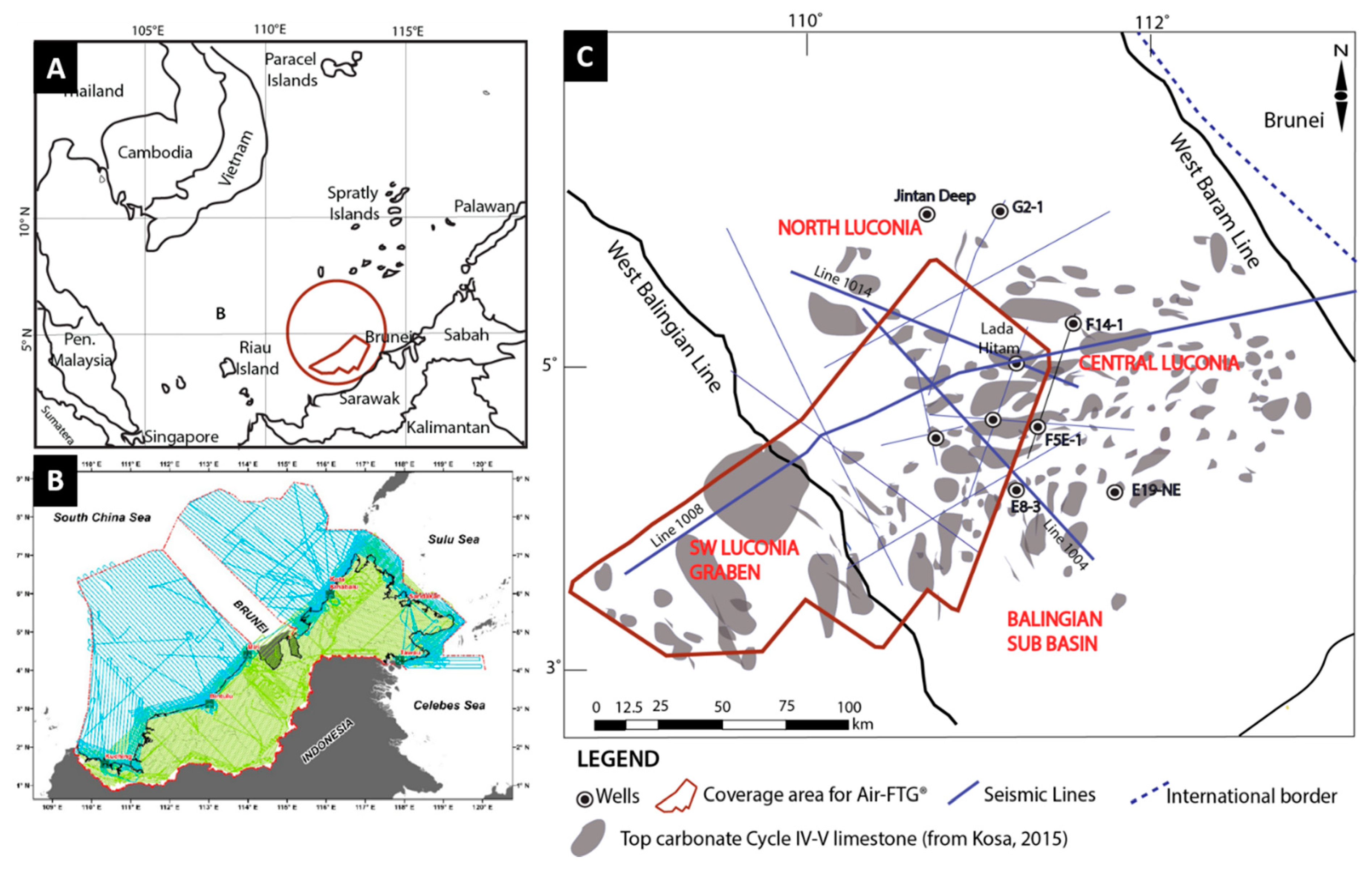

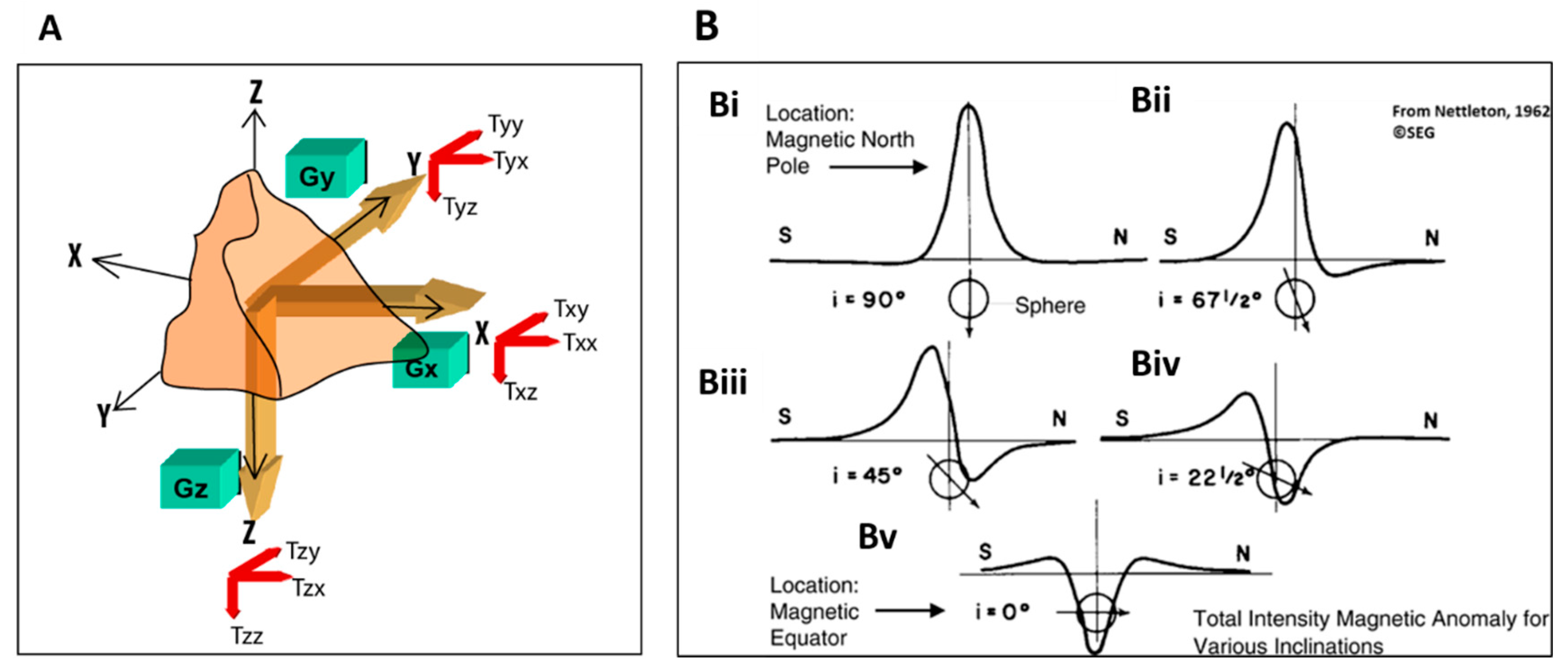

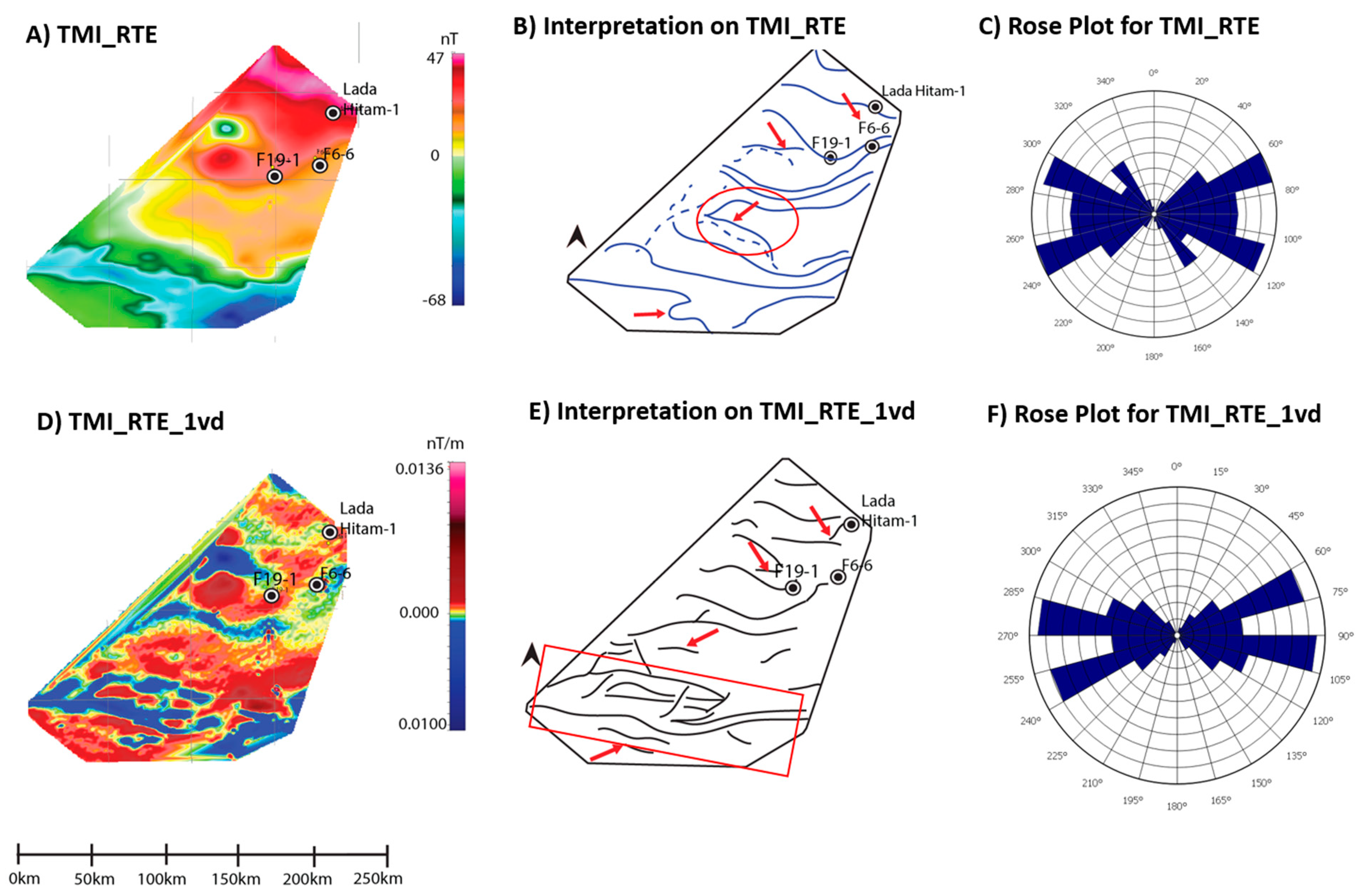
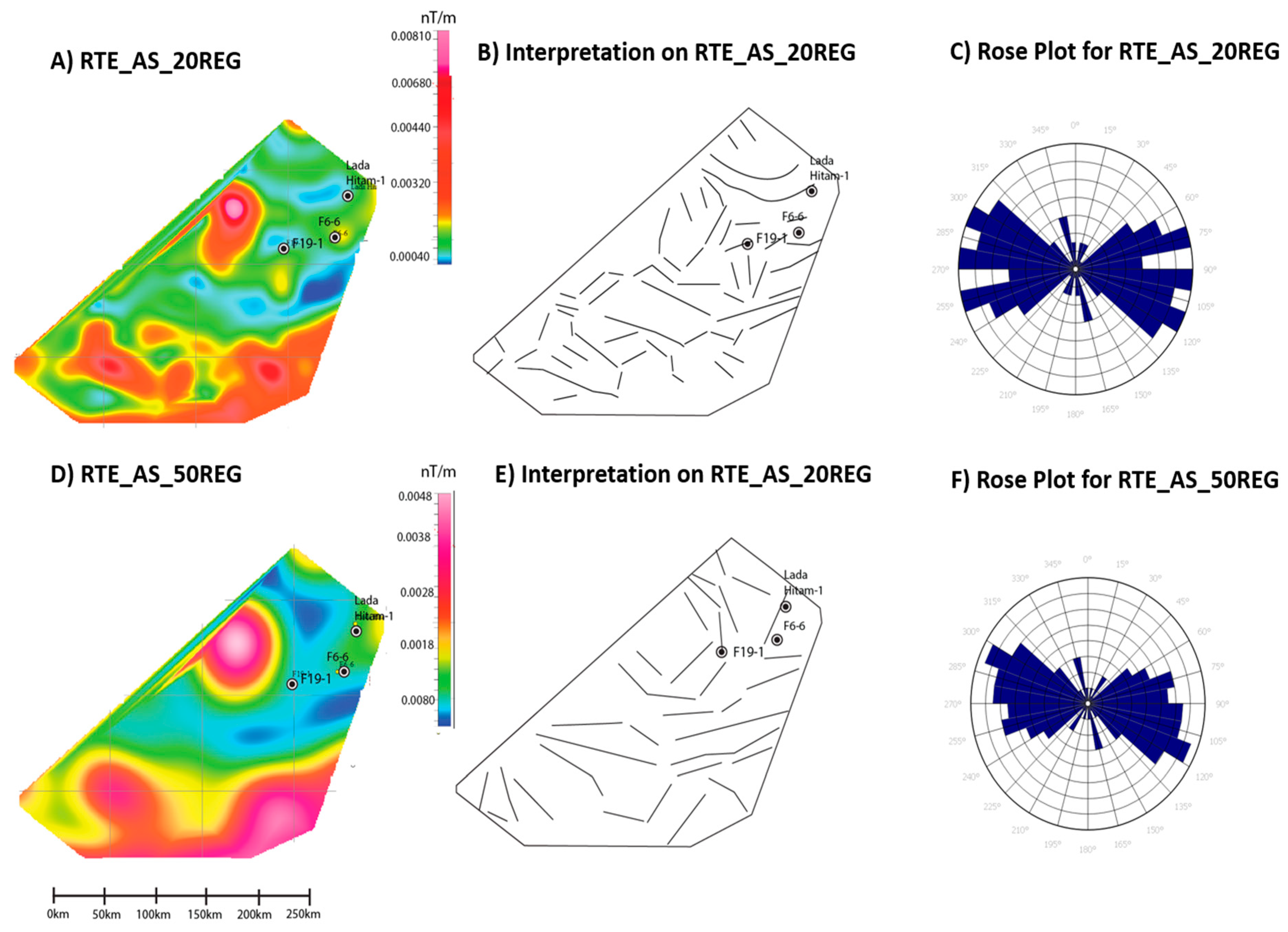
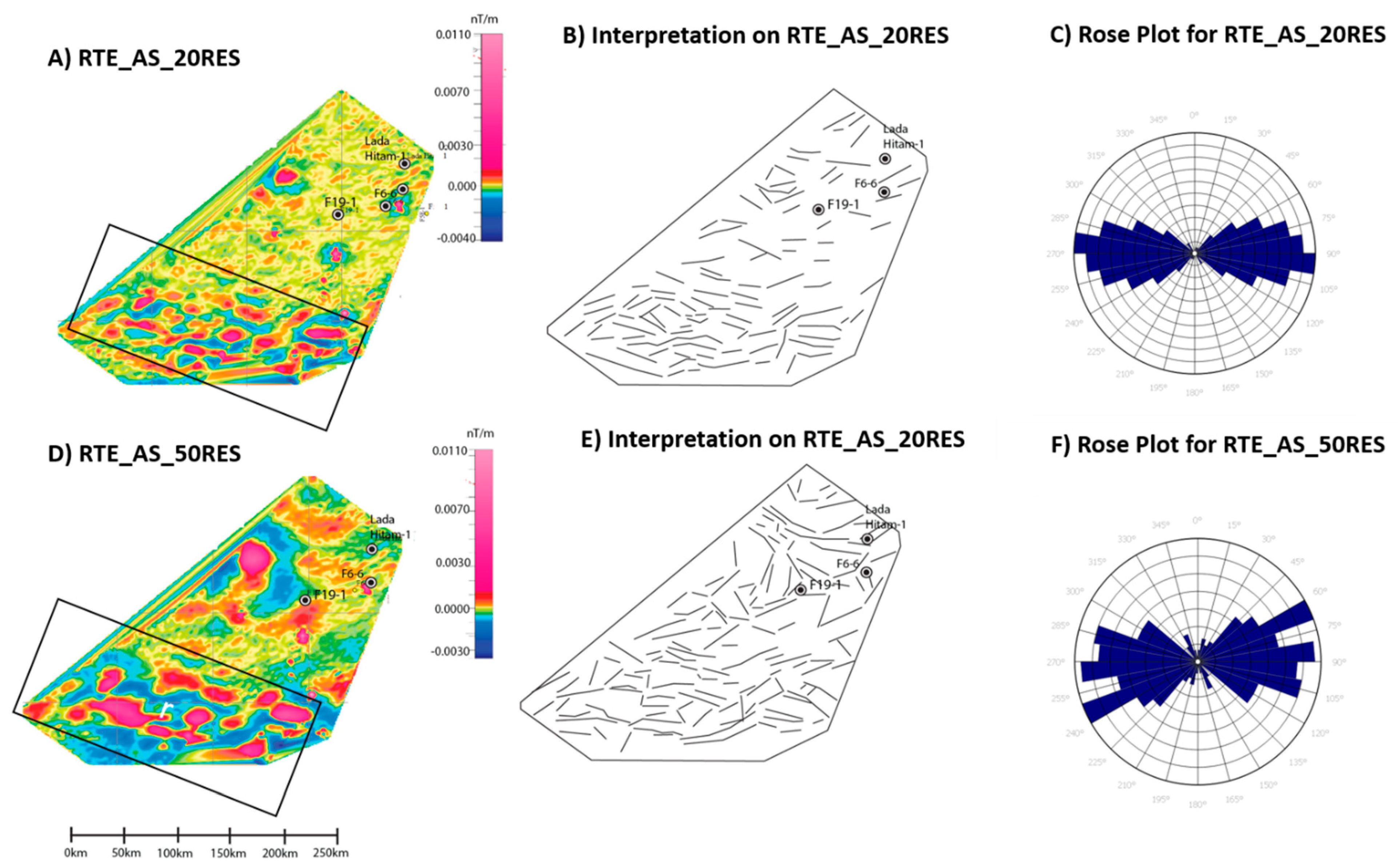

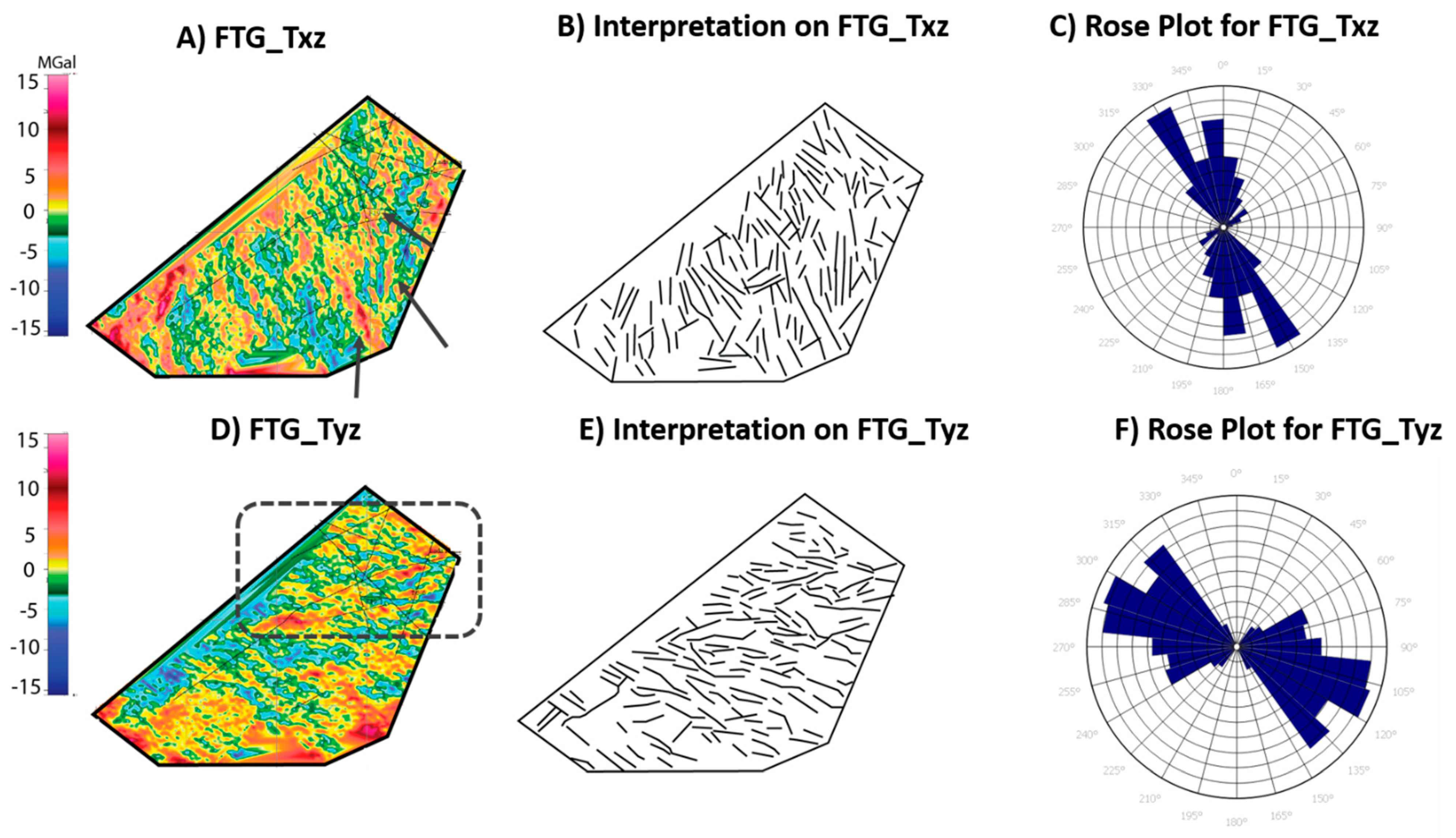
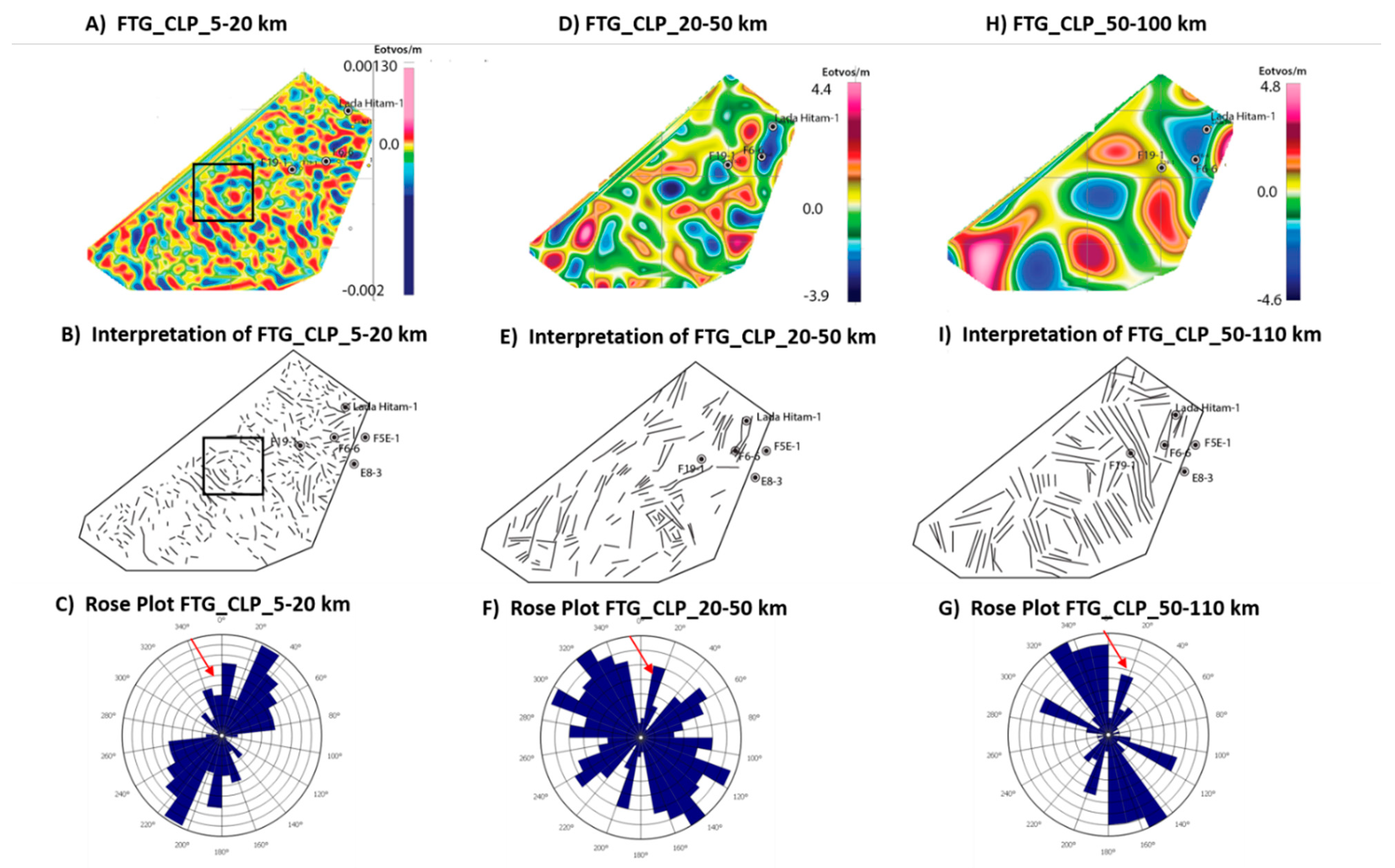

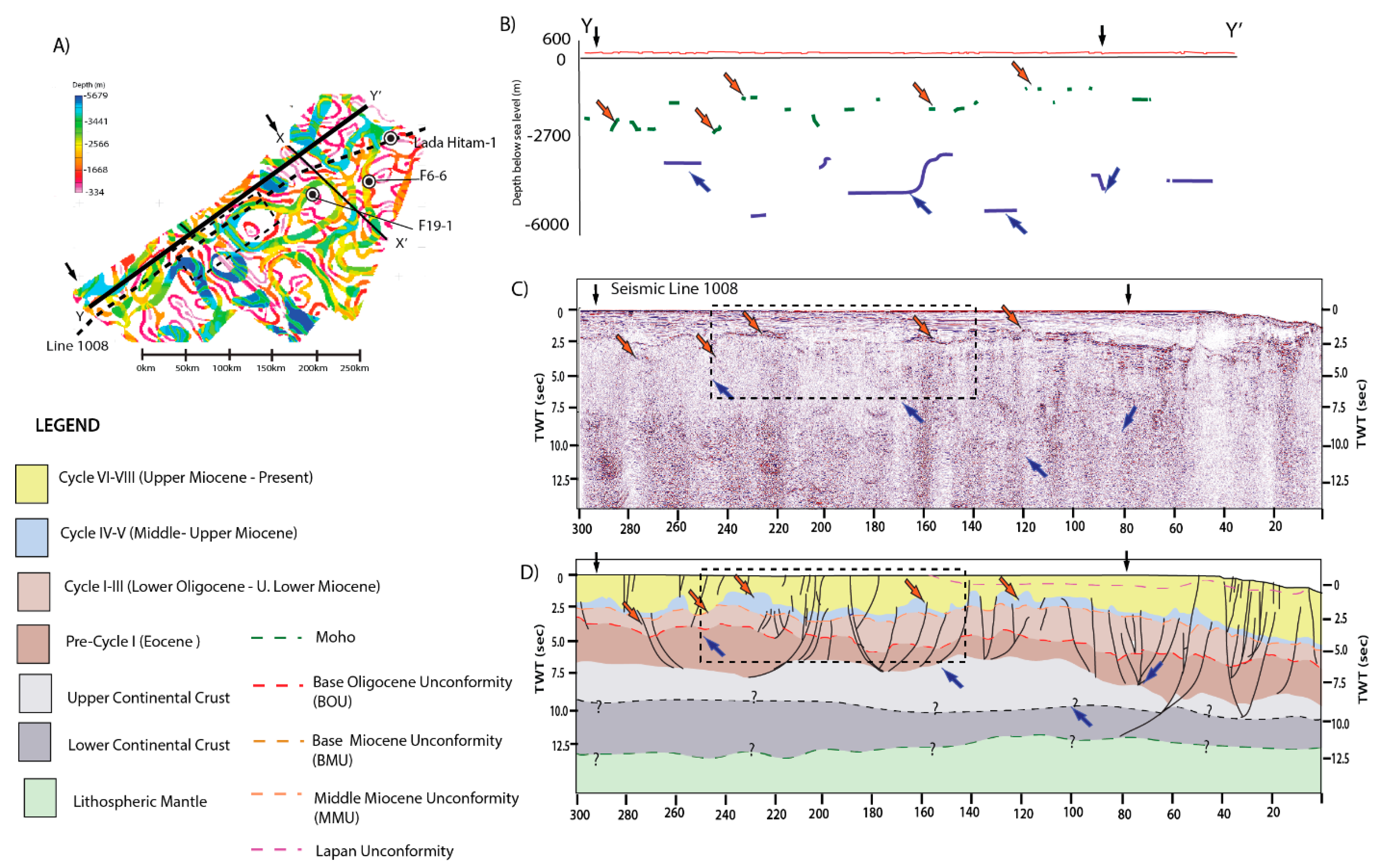
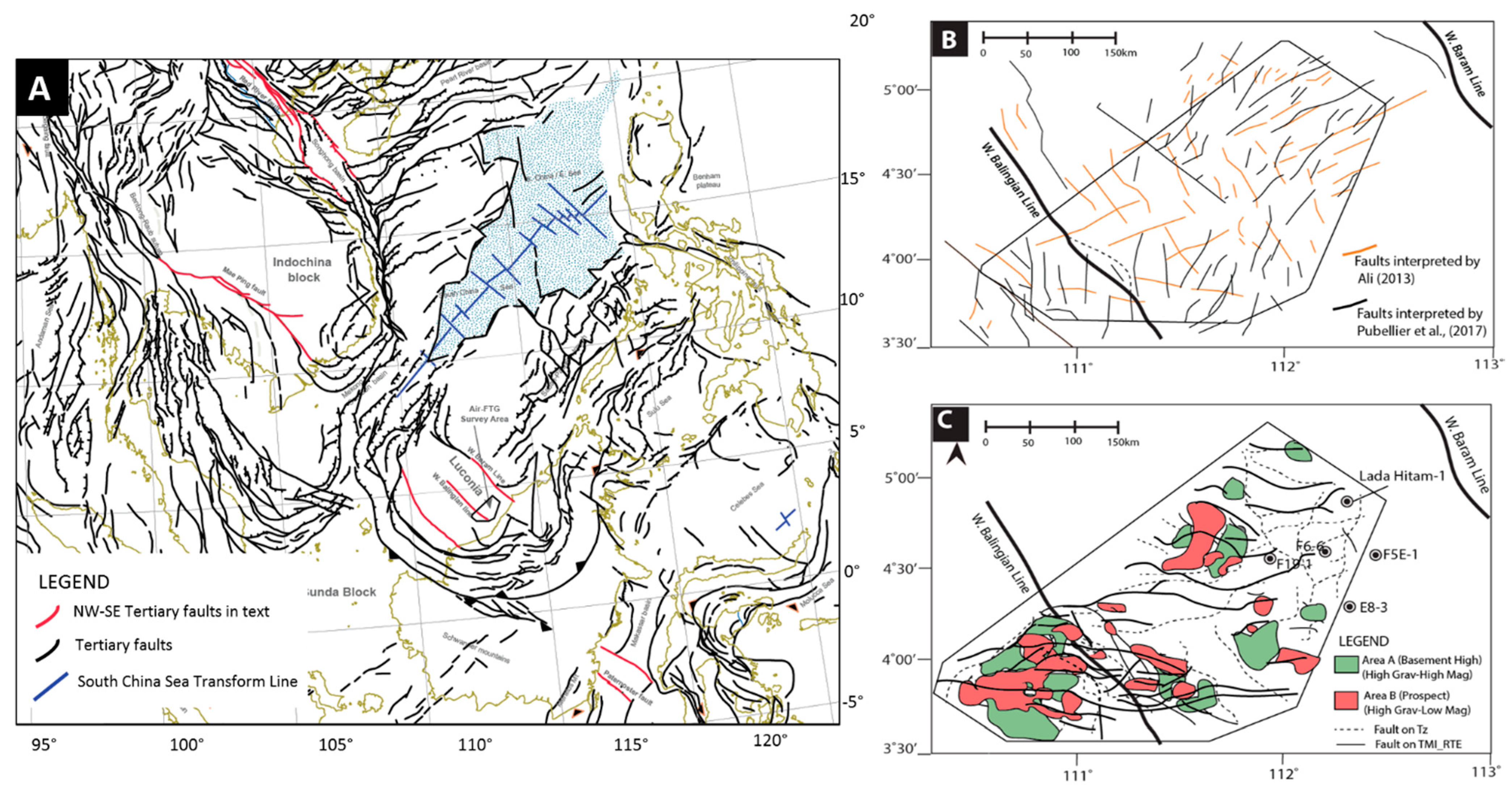
| No | Data Type | Unit | Purpose | Short Form |
|---|---|---|---|---|
| 1 | Total Magnetic Intensity (Reduced to Equator) | nT | Highlight magnetic zonation | TMI_RTE |
| 2 | 1st vertical derivative of TMI-RTE | nT/m | Better resolution of magnetic zonation | TMI_RTE_1vd |
| 3 | Analytical Signal of the first derivatives | nT/m | Captures the response of all magnetic bodies whether they are reversely magnetised or not. | RTE_AS_20res RTE_AS_20reg RTE_AS_50res RTE_AS_50reg |
| 4 | Computed Free Air Gravity (levelled and noise reduce) for depth (Z) tensor | mGal | Structural trends at depth (Txz & Tyz) and changes in density of the rocks at subsurface (Tzz) | Tz, Tzz, Txz, Tyz |
| 5 | Contact Lineament Processed (variable wavelengths) | Eotvos/m | Frequency slicing targeting structures at different depths. | CLP_short/CLP_long/CLP_int |
| No | Tensor Data | Depth Ranges | Major Trend | Minor Trend |
|---|---|---|---|---|
| Aeromagnetic | ||||
| 1 | TMI_RTE | Magnetic basement | NW-SE and NE-SW | E-W |
| 2 | TMI_RTE_1vd | Shallower than magnetic basement | E-W and NWW-SEE | E-W |
| 3 | RTE_AS_20regional | Magnetic basement | E-W and NNW-SSE | NW-SE |
| 4 | RTE_AS_50regional | Magnetic basement | E-W and NWW-SEE | NW-SE |
| 5 | RTE_AS_20residual | Magnetic basement | E-W | |
| 6 | RTE_AS_50residual | Magnetic basement | E-W and NWW-SEE | |
| Airborne Gravity | ||||
| 7 | Tz | Deep (low frequency) | NW-SE and NE-SW | All directions |
| 8 | Tzz | Shallow (high frequency) | NW-SE and ENE-WSW | NNE-SSW |
| 9 | Txz | Intermediate- Shallow | NW-SE to N-S | NE-SW |
| 10 | Tyz | Intermediate- Shallow | NW-SE to E-W | NE-SW |
| 11 | CLP_short | 2.5 to 10 km | NE-SW to E-W | NE-SW |
| 12 | CLP_intermediate | 10 to 25 km | Broad NW-SE | All directions |
| 13 | CLP_long | 25 to 55 km | NW-SE to NNW-SSE | NE-SW |
Publisher’s Note: MDPI stays neutral with regard to jurisdictional claims in published maps and institutional affiliations. |
© 2021 by the authors. Licensee MDPI, Basel, Switzerland. This article is an open access article distributed under the terms and conditions of the Creative Commons Attribution (CC BY) license (https://creativecommons.org/licenses/by/4.0/).
Share and Cite
Jamaludin, S.N.F.; Pubellier, M.; Sautter, B. Shallow vs. Deep Subsurface Structures of Central Luconia Province, Offshore Malaysia Reveal by Aeromagnetic, Airborne Gravity and Seismic Data. Appl. Sci. 2021, 11, 5095. https://doi.org/10.3390/app11115095
Jamaludin SNF, Pubellier M, Sautter B. Shallow vs. Deep Subsurface Structures of Central Luconia Province, Offshore Malaysia Reveal by Aeromagnetic, Airborne Gravity and Seismic Data. Applied Sciences. 2021; 11(11):5095. https://doi.org/10.3390/app11115095
Chicago/Turabian StyleJamaludin, Siti Nur Fathiyah, Manuel Pubellier, and Benjamin Sautter. 2021. "Shallow vs. Deep Subsurface Structures of Central Luconia Province, Offshore Malaysia Reveal by Aeromagnetic, Airborne Gravity and Seismic Data" Applied Sciences 11, no. 11: 5095. https://doi.org/10.3390/app11115095
APA StyleJamaludin, S. N. F., Pubellier, M., & Sautter, B. (2021). Shallow vs. Deep Subsurface Structures of Central Luconia Province, Offshore Malaysia Reveal by Aeromagnetic, Airborne Gravity and Seismic Data. Applied Sciences, 11(11), 5095. https://doi.org/10.3390/app11115095







